Cruithne, almost a satellite of the Earth
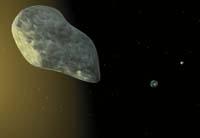
Sometimes it is very far away and sometimes it approaches Earth, but not much. However, Cruithne is classified into the set of asteroids near Earth (Near Earth Asteroids). In this name, near means proximity to the terrestrial orbit and not necessarily to the terrestrial one. Cruithne approaches Earth at a maximum of 15 million kilometers, that is, 35 times the distance from Earth to the Moon.
They do not know their shape, but astronomers have calculated that Cruithne is a “piece” of five kilometers in diameter. Therefore, once calculations have been made, at the closest time to Earth, it is almost 1,400 times smaller than the Moon. In view of this, it is no wonder his recent discovery. The discovery was made in 1986, in a photo taken in 1983 from the Australian Siding Spring Observatory. Since then, the asteroid, collecting data, published in 1997 the calculation of the exact orbit in the journal Nature.
Dance of the orbit
The article by Nature had a great impact on the media. The idea spread in the newspapers was that the Earth has a second satellite; the Moon was not alone on the journey around the Earth. It is a news of great impact, speculated for a long time with the idea of the second satellite. However, astronomers have it clear: apparently it is in an orbit around the Earth, but it is nothing more than an appearance; Cruithne is not a satellite of the Earth.
It is only possible to visualize a diagram of orbits (diagram A). The Earth has orbit around the Sun and Cruithn as well. Both orbits are apparently parallel, so from Earth it seems that the asteroid is a satellite. The image, however, makes it clear that the orbit of Cruithne is a consequence of the effect of the Sun and not of the Earth.
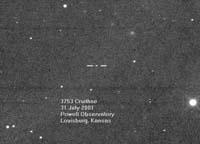
It is true that both orbits are not really parallel, among other things because of their different appearance. The orbit of Earth is almost circular and that of Cruithne is a longer ellipse, more eccentric in the language of mathematicians and astronomers. In fact, Cruithne is very close to the Sun. In the Perihelio (point closest to the Sun), Cruithne is closer to the orbit of Venus and in the apex (point further away from the Sun) it moves away to the distance of the orbit of Mars.
In view of diagram A arises the concern that Cruithne never falls to Earth. With a five-kilometer asteroid, it would be a huge disaster (which put an end to the dinosaur era to be a reference had about 10 kilometers in diameter). But that's not going to happen. Diagram B shows perfectly why. It is the diagram drawn from the plane of the orbit of the Earth, and from this point of view it is observed that the two orbits are in different planes forming an angle between them and that in no point they touch each other. In addition to the orbit of the Earth, the orbit of Cruithne is also bent by those of Mercury, Venus and Mars. There are four planets except for the risk of shock.
Orbit in alubia
Cruithn does not collide against the Earth just by the geometry of his orbits. In addition, the situation is stable, at least in the short term. Both stars, the Earth and Cruithne, are in resonance; sometimes the planet moves faster than the asteroid and sometimes backwards, but forming a complete tour, both are in the same relative position as in the previous tour. And that means that the gravitational force that interacts with each other does not vary from one turn to another. The state of a tour will be repeated exactly the same in the following. There are no surprises.
As a consequence of this movement, the orbit that forms Cruithn on each tour around the Earth has the form of beans. This aspect is seen in the Cruithne movement if we consider the position of the Earth as a fixed point. C is the representation of this diagram. At point 1, the Earth is between Cruithne and the Sun; from there, the asteroid moves toward the back of the Earth, toward point 2; then, between the Sun and the Earth, toward point 3; then, before the Earth, toward point 4; and finally, it returns to the beginning. This relative route has the form of alubia (the English call saddle, that is, for horse riding).
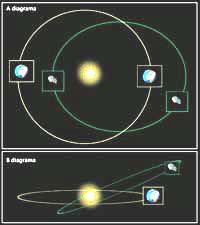
The discovery of this relative orbit was a step forward in astronomy, as astronomers had already calculated that such an orbit would be stable before discovering it. But they did not know examples. Cruithne was the first. The calculations also make it clear that the main influence of the orbit is that of the star (in this case the Sun) and not of the planet (the Earth). In short, Cruithne is not like the Moon, it is not a satellite of the Earth, but by influence of the Sun forms an orbit around the Earth: it is a pseudo-atellite.
Cycle 700 years
The truth is that the case of Cruithne was an excuse for theoretical calculus. In the short term, the orbit is ephemeral, but in the long term no. The reason is that the resonance between Earth and Cruithne is not perfect because the period of Cruithne is variable. Very little, but it changes. And that generates a long lasting cycle.
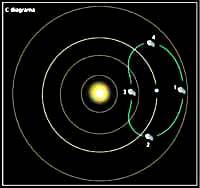
Sometimes it takes 366 days to form an orbit around the Sun. During this period the alubia moves a little every year. Point 4 of diagram C approaches the Earth. As we approach, the gravitational interaction between both stars increases at that point. Suddenly, the gravitational field of the Earth stops Cruithne and the situation suffers a great change: The period of Cruithne changes.
It seems a paradox, the velocity loss causes Cruithne to “fall” into the Sun, to leave the orbit, but that same fall again increases the speed of Cruithne in an orbit closer to the Sun. Finally the braking makes it move faster, but within another orbit.
In addition to the orbit, this phenomenon changes period. It goes from 366 days to 364 days, something inferior to the year of the Earth, which replaces the alubia. Point 4 moves away from Earth and point 2 approaches.
The cycle does not end, because Cruithne and the Earth approach much. They really do not approach much: the difference between the planes of the orbits makes point 2 never stay very close to the Earth, and the gravitation of the Earth never stops the movement of this point 2. The orbit in the form of Cruithne's alubia becomes longer and longer until it occupies almost the entire range around the Sun (diagram D). It has a horseshoe orbit. Finally, this movement goes back until the period and speed return to its initial state. The complete cycle of the Cruithne orbit lasts more than 700 years.
Sun vs Earth
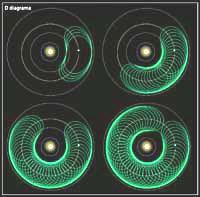
The change of shape of the orbit of Cruithne is complex from the point of view of the Earth. From the solar point of view, the orbit is an ellipse that over 700 years only changes the shape of the ellipse, that is, the semiaxes. The ellipse stretches and shortens. However, the Earth's view is easier to see how it happens.
On occasions, the orbit in the form of alubia is outside the action of the Earth. Then it is clearly seen that Cruithne is not a satellite of the Earth. What's more, then it's no pseudoelite.
In fact, Cruithne left the orbit around Earth in 1995. It becomes on the other side of the Sun and within three centuries it returns and re-enters the 'zone' of the Earth. If astronomers were found in that position, there would be no mention in the newspapers of the second moon of the Earth. But they couldn't find it the same. Excessive distance to detect a stone of five kilometers.
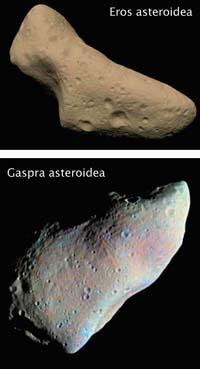
Buletina
Bidali zure helbide elektronikoa eta jaso asteroko buletina zure sarrera-ontzian











